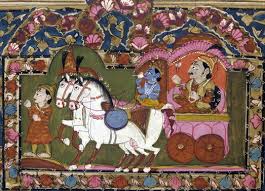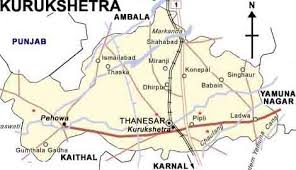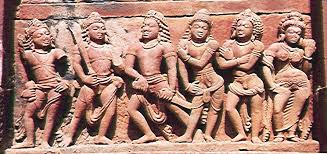महाभरत
Mahābharata
As retold by
Michael Dolan, B.V. Mahāyogi
Dear friends: Thanks for all the support and interest in my work.
I'm currently working on a retelling of Mahabharata. I started adapting Mahabharata for a graphic novel, but as I was putting stories together, I realized that I was more comfortable compiling the stories in a new version or "retelling." I'm hoping to publish this in book form.
The Mahabharata lends itself to well to this kind of treatment, since many of the stories are independent and have been the source of much of India's classical drama and literary tradition. Still, as I went through different translations to arrive at my retelling, I felt unsatisfied by the existing versions. Many of them use either a high Victorian style, antiquated and stilted. Others treat the characters as cute, fantastic, and hilarious caricatures. I'm trying to give the characters the dignity they deserve without lapsing into adulation. The Mahabharata is both tragedy and history, legend and comedy, with deep spiritual, ethical and moral teachings. Reading Mahabharata is elemental to a real understanding of India's deep cultural and religious traditions. At the same time the length of the work is daunting. Its hundred thousand Sanskrit shlokas run to about 2,500,00 words in English translation. As a story-teller I focus on a compelling narrative. Here's an excerpt from the introduction to the book, with no illustrations for the moment.
 Long before the Iliad and the
Odyssey of Homer, long before the ancient Greeks, a war was fought on the
plains of Northern India: the Kurukṣetra War. This war and its antecedents form
the story of Mahābharata, the story of Greater India and the rise and fall of
the Aryans.
Long before the Iliad and the
Odyssey of Homer, long before the ancient Greeks, a war was fought on the
plains of Northern India: the Kurukṣetra War. This war and its antecedents form
the story of Mahābharata, the story of Greater India and the rise and fall of
the Aryans.
The Aryan civilization found its
denouement in the Kurukṣetra war, the internecine
battle between the sons and grandsons of the great warrior Bhiṣma, arguably the
bloodiest battle in the ancient history of the world.
The exact age of the war is
unknown, however the Sanskrit Mahābharata was known to Aristotle, the teacher
of Alexander the Great.
Having conquered a part of the region west of the Indus
River somewhere around 500 BC, Alexander sent the spoils of his conquest to his
library in Alexandria.
Among the treasures of Alexander’s
Eastern conquest were books in Sanskrit, including the grammar of Panini, the
Upaniṣadic texts, the original Vedas in Sanskrit, and the Mahābharata. The
traditions of the poet Vyāsa, nominal composer of the work, were celebrated in
ballads, song, and theatrical works long before the time of Alexander. And
while it is difficult to assign a date to these works, they must have been
written at least hundreds of years before their discovery by the Greeks.
 |
| Scenes from Mahabharata, Rock Carvings, 7th Century, Tamil Nadu |
Since the events celebrated in epics
often take place long before they are recorded in literature, a conservative
estimate of the age of Mahābharata takes us back to at least 1000 years before
the modern Christian Era (CE). According to some traditions, the work is far
older. Some historians give the date as early as 3109 B.C. Many researchers
cite the lack of certifiable artifacts dating from this time as evidence that
the antiquity of these stories is exaggerated, however the ancient text itself
demonstrates an incredible wealth of detail about the civilizations that once
occupied the Indus River valley extending to the region of the Ganges Delta –
so claims that indicate origins in ancient antiquity cannot be easily dismissed.

The great Kurukṣetra war ended in
the total destruction of the dynasty of the Aryans who populated the region.
While different theories exist as to the racial characteristics of the Aryan
peoples so many thousands of years ago, it is hard to imagine today exactly
what happened. We may rely only on the text itself and the traditions of India
for clues. Our story takes place on the
plains of Kurukṣetra in Punjab, Northwest of present day Delhi.

We therefore must cast our vision
back into time, back thousands of years far before the time of
Shakespeare, before the time of King
Arthur, before the Aztecs sacrificed their virgins and warriors to the sun god,
before the dark ages. The heros of Mahabharata fought their battles and made
their offerings to the gods centuries before the fall of the Roman Empire, even
centuries before Jesus Christ taught in Galilee.
To apply our imagination to the
stories of the Mahabharata, we must return
to a time before Alexander the Great sat at the feet of Socrates to learn Algebra and the philosophy and
etiquette of kings.
We must travel back into the past before
the Egyptian Pyramids of Giza dominated the valleys of the Nile river basin.
And now that we have journeyed into
the past, we must then turn our vision farther east, beyond the Pyramids of the
Nile. Past the Hindu Kush. We must travel to the other side of the world, the
Orient, all the way to the wild, mystical foothills of the Himalayas, to a time
in ancient history sometime after human beings crawled out of the ice age and
began organizing themselves into agricultural communities.
 |
| Artists depiction of ancient Himalayan Civilization in Harappa |
Farming took place with the
domestication of oxen, horse, and elephant. The domestication of the cow, the
cultivation of rice, bananas, and wheat were achieved by the Mohenjo-Daro
civilization that grew near the now-extinct basin of the Saraswati River. (http://www.mohenjodaro.net/)
A civilization was born from agricultural
cultivation. Gradually towns and cities arose. How South Asia came to be populated
with citizens and their kings is an enigma shrouded in mystery.
 |
| Remains of Indus Valley Civilization at Harappa |
But how the
ancient kings of the Aryan civilization ruled, did battle, and celebrated
peace, how they thrived and were finally ruined are the subjects of our story.
Their lives have been recorded in the meters of Vyasadeva’s poetry as
Mahabharata.
 |
| Kailash rock-cut temple. |
Paṇḍu and his blind brother Dhṛtaraṣṭra
were the respective kings of Hastinapura, the place of the elephants. Modern
archeologists have placed the ruined walls of the palaces of Hastinapura nearby
the original city of New Delhi.
At the time of our story, Hastinapura was the seat of the ancient rulers
of India. When King Paṇḍu died, before his time, his brother Dhṛtaraṣṭra
reluctantly became regent-king ruling until the next generation was fit to
inherit the kingdom. A rivalry grew between his nephews, the sons of Paṇḍu, along with his
own hundred sons headed by the eldest; Duryodhana.
 |
| Pandavas & Draupadi with Akshaya Patra (Source: Amba Theertha, near Kalasa, Karnataka |
The sons of Paṇḍu were called the Paṇḍavas . Of the Five Paṇḍavas,
Yudhiṣthira also the eldest, was a man of righteousness and truth. Bhīma was a
powerful warrior, mighty and stong, with a warriors appetite. . Arjuna was to
become the greatest archer who ever
lived. Their two younger brothers were the twins: Nakula and Sahadeva: both
handsome, elegant, masters of poetry, lovers of women and noble warriors.
There are many versions of
Mahabharata: the story is often told in summary fashion. The complete version
begins years after the battle has finished.
 |
| Black and White Image of an Antique Medallion showing Arjuna and Hanuman |
Arjuna was brother-in-law to
Krishna his intimate friend. With Subhadra, the sister of Krishna, Arjuna begat
Abhimanyu. The son of Arjuna was Abhimanyu. With Uttara, Abhimanyu begat
Pariksit, who became king of all the Indias and ruled in peace after the
Kuruksetra war. Unfortunately, as the result of a brahmana’s curse, Pariksit
was doomed to die of snake-bite. The pious Pariksit turned to Sukadeva Goswami
and heard the message of Bhagavat Purana from him for seven days before being
attacked and killed by Taksaka, a great snake.

The son of Pariksit is Janamejaya. Determined
to rid the world of snakes, he begins a great sacrifice. Many great snakes are
burned in the sacrificial fire when Astika, a young Brahmana steps forward and
begs a boon. When the boon is granted, the boy asks the king to stop the
sacrifice on the grounds that mercy is above justice.
 He explains the nature of
the feud between Pariksit and the snakes, which really began in ancient times
when Arjuna and Krishna burned the forest of Khandava-prastha. Janamejaya’s rage against the snakes is ultimately
pacified, but his curiosity is piqued. He wants to know how Arjuna came to burn
the forest and hear the entire history of his ancestors, the rulers of India.
He explains the nature of
the feud between Pariksit and the snakes, which really began in ancient times
when Arjuna and Krishna burned the forest of Khandava-prastha. Janamejaya’s rage against the snakes is ultimately
pacified, but his curiosity is piqued. He wants to know how Arjuna came to burn
the forest and hear the entire history of his ancestors, the rulers of India.
 |
| Fire-god Agni disguised as brahmana asks Krishna and Arjuna to burn the Khandava forest, Bas Relief, |
Vaishampayana enters the assembly.
The gathered brahmaṇas offer him a chair of honor in the snake sacrifice. He is dressed in a deer skin with matted hair
and sits on a kusha grass mat before King Janamejaya and begins to tell the
ancient histories of the Mahabharata.
 He begins by telling of how, before the
pious rule of Bharata and his descendants, the ksatriyas or warrior class had
committed many abuses. Before the golden age of Bhishmadeva, these ruthless
dictators persecuted brahmaṇas, raped the land, destroyed rivers and forests,
plundered and killed the innocent. They demanded tribute in the form of gold
and silver. They raped virgins and violated the principles of religion. The
earth was soaked in blood and the rivers ran red. The earth was overburdened with the weight of militaristic kings. And so it was that Bhumidevi, the earth in the form of a cow, came to pray to Vishnu and beg for help against
these injustices. At this time, the earth was exhausted from exploitation. Kṛṣṇa, determined to
alleviate the suffering of the earth, set into motion a sequence of events that
would culminate in the Kurukṣetra War, the First Great War of Kings.
He begins by telling of how, before the
pious rule of Bharata and his descendants, the ksatriyas or warrior class had
committed many abuses. Before the golden age of Bhishmadeva, these ruthless
dictators persecuted brahmaṇas, raped the land, destroyed rivers and forests,
plundered and killed the innocent. They demanded tribute in the form of gold
and silver. They raped virgins and violated the principles of religion. The
earth was soaked in blood and the rivers ran red. The earth was overburdened with the weight of militaristic kings. And so it was that Bhumidevi, the earth in the form of a cow, came to pray to Vishnu and beg for help against
these injustices. At this time, the earth was exhausted from exploitation. Kṛṣṇa, determined to
alleviate the suffering of the earth, set into motion a sequence of events that
would culminate in the Kurukṣetra War, the First Great War of Kings.

We begin with the end of the great
Kurukṣetra war. Amid the ruins of the killing fields huddle a single handful of
battle-scarred warriors. Their shields are bent, their quivers exhausted, their
faces bloody. They are covered in sweat and blood, and the dust of the
war-grounds.
 Their limbs are scarred, their bodies torn with arrows. These are
the five Paṇḍavas, victorious in the battle, the new lords of Hastinapura. They
are among the only survivors of the devastating war. They have defeated the
envious Kauravas, but at what cost?
Their limbs are scarred, their bodies torn with arrows. These are
the five Paṇḍavas, victorious in the battle, the new lords of Hastinapura. They
are among the only survivors of the devastating war. They have defeated the
envious Kauravas, but at what cost?










